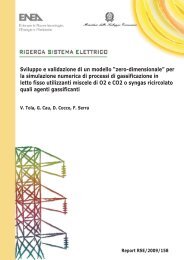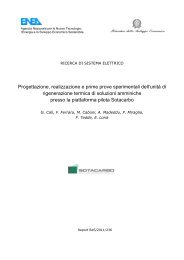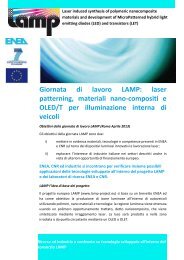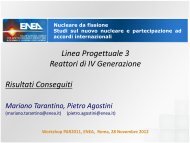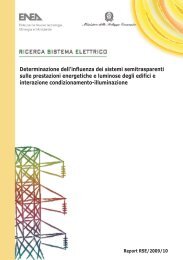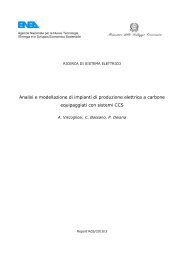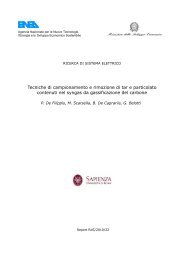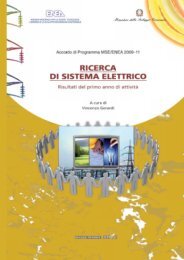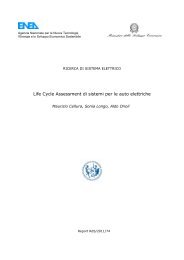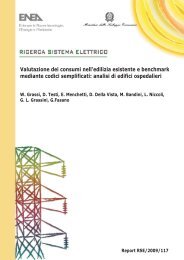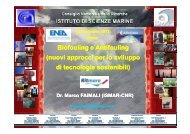Sviluppo di moduli batterie litio-ioni per avviamento - Enea
Sviluppo di moduli batterie litio-ioni per avviamento - Enea
Sviluppo di moduli batterie litio-ioni per avviamento - Enea
Create successful ePaper yourself
Turn your PDF publications into a flip-book with our unique Google optimized e-Paper software.
Altra caratteristica della cella NMC è il maggiore valore del rapporto Potenza/Energia: tale<br />
parametro è <strong>di</strong> fondamentale importanza <strong>per</strong> un ibrido dove l’orientamento è quello <strong>di</strong> avere<br />
sistemi prevalentemente <strong>di</strong> “potenza”.<br />
Il ren<strong>di</strong>mento <strong>di</strong> carica risulta essere maggiore <strong>per</strong> le Celle NMC e allo stesso tempo più stabile<br />
al variare delle correnti <strong>di</strong> scarica: si hanno minori <strong>per</strong><strong>di</strong>te <strong>di</strong> carica tra ingresso e uscita.<br />
Anche <strong>per</strong> quel che riguarda il ren<strong>di</strong>mento energetico le Celle NMC presentano caratteristiche<br />
migliori sia in termini assoluti sia in termini <strong>di</strong> variaz<strong>ioni</strong> alle <strong>di</strong>fferenti C rate <strong>di</strong> scarica: ciò<br />
in<strong>di</strong>ca una migliore qualità della cella NMC.<br />
I medesimi parametri definiti sopra sono stati verificati anche a <strong>di</strong>fferenti tem<strong>per</strong>ature <strong>di</strong><br />
funzionamento, con scarica a 1 C, ottenendo i risultati riportati in tabella. Il confronto <strong>per</strong> la<br />
cella NMC è stato effettuato tra la tem<strong>per</strong>atura ambiente (23 °C) e quella a 0 °C, <strong>per</strong>ché la<br />
prova a 40°C è risultata poco atten<strong>di</strong>bile.<br />
Caratteristiche delle prestaz<strong>ioni</strong> scarica 1 C<br />
NMC LFP<br />
0 °C RT 40 °C 0 °C RT 40 °C<br />
Capacità (Ah) 27.08 31.93 33.81 42.16 47.60 45.8<br />
Energia specifica (Wh/kg) 112.02 137.39 146.28 80.33 95.73 92.67<br />
Densità energetica (Wh/l) 239.38 293.57 312.57 134.28 159.85 154.9<br />
Potenza specifica me<strong>di</strong>a (W/kg) 128.64 133.31 143.50 76.85 80.50 80.94<br />
Densità me<strong>di</strong>a <strong>di</strong> potenza (W/l) 274.88 284.86 306.64 28.46 134.55 135.28<br />
Ren<strong>di</strong>mento <strong>di</strong> carica (%) 91.44 97.11 98.53 88.07 97.31 97.41<br />
Ren<strong>di</strong>mento energetico (%) 81.73 93.09 95.84 73.91 88.93 90.92<br />
Tabella 73 - Caratteristiche <strong>di</strong> scarica 1 C a <strong>di</strong>fferente tem<strong>per</strong>atura a confronto<br />
In termini assoluti i parametri della cella NMC alle due tem<strong>per</strong>ature presentano valori su<strong>per</strong>iori<br />
alla LFP, con circa le medesime <strong>per</strong>centuali prima evidenziate.<br />
La variazione <strong>per</strong>centuale, invece, <strong>per</strong> la medesima cella a <strong>di</strong>fferenti tem<strong>per</strong>ature risulta<br />
su<strong>per</strong>iore nel caso della cella NMC: infatti a 0°C la cella NMC presenta una capacità ridotta del<br />
15.2 % (LFP 11.5 %) con un’energia ridotta del 18.5% (LFP 16 %). A tale vantaggio, <strong>per</strong>ò, la<br />
cella LFP unisce lo svantaggio <strong>di</strong> avere ren<strong>di</strong>menti (coulombiano ed energetico) molto più bassi<br />
in termini assoluti con variaz<strong>ioni</strong> in funzione della tem<strong>per</strong>atura molto più accentuate. Infine la<br />
potenza risulta essere pressoché costante alle <strong>di</strong>fferenti tem<strong>per</strong>ature (<strong>per</strong> le NMC ± 3.5 %<br />
mentre <strong>per</strong> le LFP ± 5 %).<br />
Per quel che riguarda la potenza <strong>di</strong> picco si riportano nella seguente tabella i valori <strong>per</strong> le due<br />
celle ai <strong>di</strong>fferenti SOC sia in termini <strong>di</strong> massa che <strong>di</strong> volume:<br />
146



